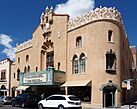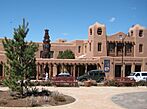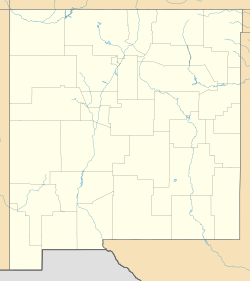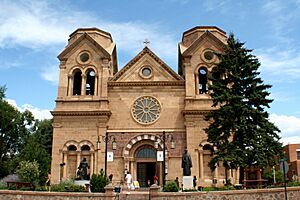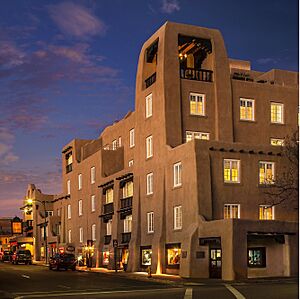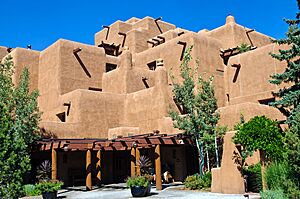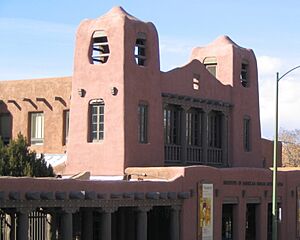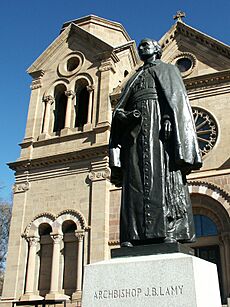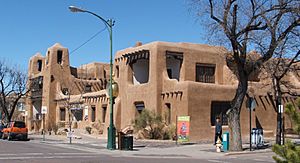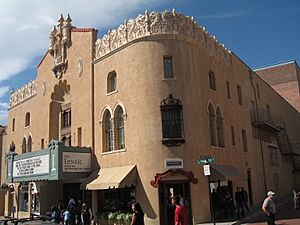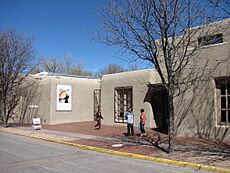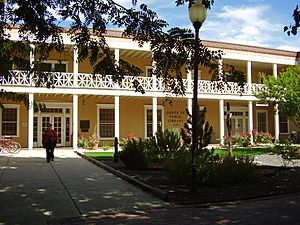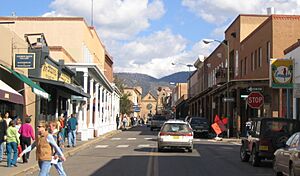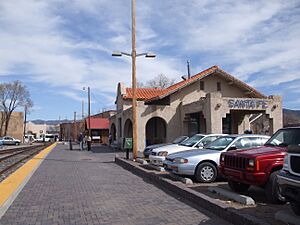Santa Fe, New Mexico facts for kids
Quick facts for kids
Santa Fe, New Mexico
La Villa Real de la Santa Fe de San Francisco de Asís
|
|||
|---|---|---|---|
|
|||
| Etymology: Spanish for "Holy Faith" | |||
| Nickname(s):
The City Different
|
|||
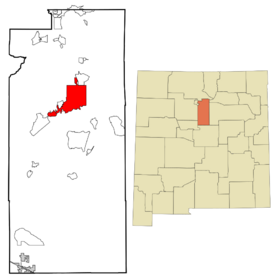
Location in Santa Fe County, New Mexico
|
|||
| Country | United States | ||
| State | New Mexico | ||
| County | Santa Fe | ||
| Founded | 1610 | ||
| Founded by | Pedro de Peralta | ||
| Named for | St. Francis of Assisi | ||
| Area | |||
| • City | 52.34 sq mi (135.57 km2) | ||
| • Land | 52.23 sq mi (135.28 km2) | ||
| • Water | 0.11 sq mi (0.29 km2) | ||
| Elevation | 6,998 ft (2,133 m) | ||
| Population
(2020)
|
|||
| • City | 87,505 | ||
| • Density | 1,675.28/sq mi (646.83/km2) | ||
| • Metro | 154,823 (Santa Fe MSA) 1,162,523 (Albuquerque-Santa Fe-Los Alamos CSA) |
||
| Demonym(s) | Santa Fean; Santafesino, -na | ||
| Time zone | UTC−7 (MST) | ||
| • Summer (DST) | UTC−6 (MDT) | ||
| ZIP Codes |
87501–87509, 87540, 87592, 87594
|
||
| Area code(s) | 505 | ||
| FIPS code | 35-70500 | ||
| GNIS feature ID | 936823 | ||
| Primary airport | Santa Fe Regional Airport KSAF (Public) |
||
Santa Fe is the capital city of New Mexico, a state in the United States. It is also the main city of Santa Fe County. With over 87,000 people, Santa Fe is the fourth-largest city in New Mexico. It is part of a bigger area that includes Albuquerque and Los Alamos.
Santa Fe is located at the base of the Sangre de Cristo Mountains. It is the highest state capital in the U.S., sitting at 6,998 feet (2,133 m) above sea level.
The city was started in 1610 by the Spanish. It was the capital of a Spanish province called Nuevo México. This makes Santa Fe the oldest state capital in the United States. It is also the oldest European settlement west of the Mississippi River. Its name means "Holy Faith" in Spanish. The full name is La Villa Real de la Santa Fe de San Francisco de Asís, which means "the Royal Town of the Holy Faith of Saint Francis of Assisi".
After Mexico became independent from Spain in 1821, Nuevo México became a Mexican territory. The U.S. gained the area in 1848 after the Mexican–American War. In 1851, Santa Fe became the capital of the U.S. Territory of New Mexico. It became New Mexico's state capital in 1912.
Santa Fe grew as a major trading and travel center. Important routes like El Camino Real de Tierra Adentro and the Santa Fe Trail helped it prosper. The city has always been a key place for politics and culture in New Mexico. This is true through its Spanish, Mexican, and American history.
Today, Santa Fe mixes Native American, Spanish, and American influences. It is known as the cultural capital of the Southwestern United States. Many people see it as one of the best art cities in the country. In 2005, it was the first U.S. city to join the UNESCO Creative Cities Network. Santa Fe has over 250 art galleries, many museums, and three big art events each year. These include the Santa Fe International Folk Art Market and the Indian Market. A lot of jobs in Santa Fe are in art and culture.
Some famous places in Santa Fe are Santa Fe Plaza, the Palace of the Governors, and the Fiesta de Santa Fe. The city is also known for its unique food and music. Art places like the Georgia O'Keeffe Museum and Meow Wolf are popular. The city's buildings often use the Pueblo Revival and Territorial Revival architecture styles. These styles look like old adobe buildings.
Contents
- What Does the Name Santa Fe Mean?
- Santa Fe's Rich History
- Santa Fe's Geography and Climate
- Who Lives in Santa Fe?
- Santa Fe's Economy
- Arts and Culture in Santa Fe
- Sports in Santa Fe
- Education in Santa Fe
- Getting Around Santa Fe
- Santa Fe's Sister Cities
- Famous People from Santa Fe
- Images for kids
- See also
What Does the Name Santa Fe Mean?
Before Europeans arrived, the area where Santa Fe is now was known by different names. The Tewa people called it Oghá P'o'oge. This means "white shell water place." The Navajo people called it Yootó, which means "bead water place." These names often referred to places with water.
In 1598, Juan de Oñate named the area Santa Fe de Nuevo México. This was a province of New Spain. Later, in 1607, the governor Pedro de Peralta gave the city its full name: La Villa Real de la Santa Fé de San Francisco de Asís. This means "the Royal Town of the Holy Faith of Saint Francis of Assisi".
Santa Fe's Rich History
The Santa Fe area was first home to Tanoan people. They lived in many Pueblo villages along the Rio Grande. One of the oldest known villages in downtown Santa Fe was built around 900 AD. The Tewa built homes around what is now the Plaza. This village was called Oghá P'o'oge. The Pueblo people lived along the Santa Fe River from the 11th to 12th centuries. They left the area about 200 years before the Spanish arrived in the early 1600s.
Spanish Rule and Early Settlements

In 1598, Don Juan de Oñate led the first Spanish group to settle the region. He made Santa Fe de Nuevo México a province of New Spain. The first capital was San Juan de los Caballeros, north of Santa Fe. Juan de Oñate was later removed from power because he was cruel to the Native people.
New Mexico's second Spanish governor, Don Pedro de Peralta, started a new city in 1607. He built it at the foot of the Sangre de Cristo Mountains. He named it La Villa Real de la Santa Fé de San Francisco de Asís. In 1610, he made it the capital of the province. It has been the capital almost continuously since then. This makes it the oldest state capital in the United States.
Native American groups felt they were not treated fairly by the Spanish government. This led to the Pueblo Revolt in 1680. Different Pueblo people groups successfully forced the Spanish out of New Mexico. The Pueblo people then governed New Mexico from the Palace of the Governors in Santa Fe from 1680 to 1692.
In 1692, Don Diego de Vargas took back the territory. This event is sometimes called the "Bloodless Reconquest." The next governor, Francisco Cuervo y Valdez, worked to make peace. He helped found Albuquerque to give Pueblo people better representation and trade access. Other governors, like Tomás Vélez Cachupin, also worked well with the Native population.

Santa Fe Under Mexican Rule
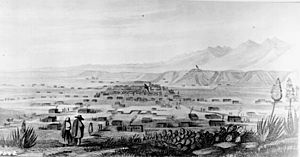
Santa Fe was the main city for the Spanish province when the Mexican War of Independence began in 1810. It was important for fur traders. After Mexico became independent from Spain, Santa Fe remained the capital of the Mexican territory of Santa Fe de Nuevo México. This was made official in the 1824 Constitution.
Santa Fe stayed a key center for trade and travel west of the Mississippi River. Starting in the 1820s, the Santa Fe Trail brought valuable trade links to Missouri. This attracted both Native American and European-American traders. This trade also helped build good relationships between Mexico and the United States.
In 1836, the Republic of Texas broke away from Mexico. Texas tried to claim Santa Fe and other parts of Nuevo México. In 1841, a small group from Austin tried to take control of the Santa Fe Trail. This group, called the Texan Santa Fe Expedition, was not ready and was easily captured by the New Mexican military.
Despite these events, Santa Fe continued to be a place where many people traveled and traded. Three main trails led to the city. Later, these trails would be replaced by railroads, Route 66, and interstates.
Santa Fe Becomes Part of the United States
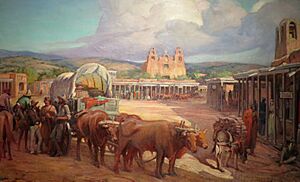
In 1846, the United States went to war with Mexico. General Stephen W. Kearny led his army into Santa Fe. He claimed the city and all of the New Mexico Territory for the U.S. By 1848, the U.S. officially gained New Mexico through the Treaty of Guadalupe Hidalgo.
After Texas became part of the U.S., it also claimed Santa Fe. However, these land disputes were settled by the Compromise of 1850. This agreement set Texas's western border and created the New Mexico Territory.

Some early American visitors did not see much potential in Santa Fe. One traveler in 1849 wrote that the area was dry and sandy. He described the streets as narrow and the people as poor.
In 1851, Jean Baptiste Lamy arrived. He became the bishop for a large area including New Mexico. He helped build the Saint Francis Cathedral in Santa Fe. He greatly influenced Catholicism in the region until he passed away in 1888.
During the American Civil War, General Henry Hopkins Sibley and his Confederate troops took over Santa Fe for a few days in March 1862. But Union troops destroyed their supplies, forcing Sibley to leave after the Battle of Glorieta Pass. The Santa Fe National Cemetery was created in 1870 for Union soldiers who died fighting there.
In 1887, Anton Docher, a priest, was ordained in Santa Fe. He later wrote about life in the Pueblos in the early 1900s.
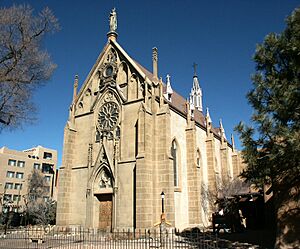
Santa Fe was supposed to be a major stop on the Atchison, Topeka and Santa Fe Railway. However, engineers decided it was easier to build the main tracks through Lamy, a town south of Santa Fe. A smaller branch line was built from Lamy to Santa Fe in 1880. The city of Santa Fe was officially formed on June 17, 1891.
Because the main railroad bypassed Santa Fe, the city's economy slowly declined. But artists, writers, and retirees were drawn to the area's culture, beautiful scenery, and dry climate. City leaders began to promote Santa Fe as a tourist spot. They restored old buildings and built new ones using traditional styles. This created the unique Santa Fe Style.
Edgar Lee Hewett, an archaeologist, was a big supporter of this. He started the Santa Fe Fiesta in 1919 and the Southwest Indian Fair in 1922 (now the Indian Market).
Santa Fe in the 20th Century
In 1912, New Mexico became the 47th U.S. state, with Santa Fe as its capital. The city had about 5,000 people. City leaders created a plan to develop the city while keeping its unique character. They considered the limited water supply and future growth.
After the main railroad line bypassed Santa Fe, the city's population dropped. However, artists, writers, and retirees were attracted to the area's rich culture, beautiful landscapes, and dry climate. Local leaders started promoting the city for tourism. They supported projects to restore old buildings and build new ones using traditional methods and styles. This led to the unique Santa Fe Style.
Edgar Lee Hewett, who founded the School of American Research and the Museum of New Mexico, was a key promoter. He started the Santa Fe Fiesta in 1919 and the Southwest Indian Fair in 1922 (now called the Indian Market).
During World War II, the U.S. government built a Japanese-American internment camp near Santa Fe. Japanese-American men were held there, even without evidence of wrongdoing. Later, German and Italian citizens were also held there. In 1945, there was a conflict between the people held in the camp and the guards, known as the Santa Fe Riot. The camp closed in 1946.

Santa Fe's Geography and Climate

Santa Fe covers about 52.34 square miles (135.57 km²). Most of this area is land.
The city is about 7,199 feet (2,133 m) above sea level. This makes it the highest state capital in the United States.
The Santa Fe River and small streams called arroyos flow through the area. They drain into the Rio Grande.
Santa Fe's Weather
Santa Fe has cool, dry winters and hot summers. It does not get much rain. The average temperature changes a lot between day and night. This is because the air is dry and the city is high up.
The city usually gets six to eight snowfalls each year, from November to April. The most rain falls in July and August, during the North American Monsoon.
Who Lives in Santa Fe?
| Historical population | |||
|---|---|---|---|
| Census | Pop. | %± | |
| 1850 | 4,846 | — | |
| 1860 | 4,635 | −4.4% | |
| 1870 | 4,756 | 2.6% | |
| 1880 | 6,635 | 39.5% | |
| 1890 | 6,185 | −6.8% | |
| 1900 | 5,603 | −9.4% | |
| 1910 | 5,073 | −9.5% | |
| 1920 | 7,326 | 44.4% | |
| 1930 | 11,176 | 52.6% | |
| 1940 | 20,325 | 81.9% | |
| 1950 | 27,998 | 37.8% | |
| 1960 | 34,394 | 22.8% | |
| 1970 | 41,167 | 19.7% | |
| 1980 | 48,053 | 16.7% | |
| 1990 | 52,303 | 8.8% | |
| 2000 | 61,109 | 16.8% | |
| 2010 | 67,947 | 11.2% | |
| 2020 | 87,505 | 28.8% | |
| U.S. Decennial Census | |||
In 2020, 87,505 people lived in Santa Fe. This was a good increase from 67,947 people in 2010.
Many different groups of people live in Santa Fe. In 2020, about 41.4% of the people were White (not Hispanic). About 51% of the people were Hispanic or Latino. Other groups include Native American, Black, and Asian people.
Santa Fe has a history of being a welcoming place for many different communities.
Santa Fe's Economy
Santa Fe's economy focuses on several key areas. These include:
- Arts and Culture
- Design
- Hospitality (things like hotels and restaurants)
- Conservation Technologies (ways to protect nature)
- Software Development
- Publishing and New Media
- Outdoor Gear and Apparel
Other important areas for the economy are healthcare, services for retired people, and food and drinks.
Tourism in Santa Fe
Tourism is a very important part of Santa Fe's economy. People visit all year round. They come for the weather and outdoor activities like skiing and hiking. They also enjoy the city's cultural events.
Many tourist activities happen in the historic downtown area. This includes the Santa Fe Plaza, a square next to the Palace of the Governors. Other popular spots are "Museum Hill," which has several art museums, and Canyon Road, known for its many art galleries.
In September, the aspen trees in the Sangre de Cristo Mountains turn yellow, which is beautiful. This is also when the annual Fiestas de Santa Fe takes place. A highlight of this festival is burning Zozobra ("Old Man Gloom"), a 50-foot tall puppet.
Visitors can also take day trips to nearby places. These include Taos, Bandelier National Monument, and the Valles Caldera. Ski Santa Fe, a ski resort, is also close by. Many locals also visit Chimayo for an annual pilgrimage.
Science and Technology in Santa Fe
Santa Fe has been linked to science and technology since 1943. That's when the Los Alamos National Laboratory (LANL) was started nearby. In 1984, the Santa Fe Institute (SFI) was founded to study complex systems in science and other fields. It has hosted Nobel Prize winners. The National Center for Genome Resources (NCGR) was created in 1994. It focuses on research that combines biology, computers, and math.
Because of LANL, SFI, and NCGR, Santa Fe often hosts scientific meetings, summer schools, and public talks.
Arts and Culture in Santa Fe
Santa Fe is famous for its arts, which show the city's many cultures. Since 2005, it has been a UNESCO Creative City for Crafts and Folk Art.
Santa Fe's Architecture
The Spanish planned Santa Fe around a central plaza. The Palace of the Governors was on the north side, and a church (now the Cathedral Basilica of Saint Francis of Assisi) was on the east.
The city's streets spread out from the Plaza. Many were narrow. As the city grew, building styles changed. By 1912, the city looked like many other U.S. towns. To attract tourists, the city decided to create a unified building style.
This new style was the Santa Fe Pueblo Revival look. It was based on the old adobe homes and churches. It used features like vigas (exposed wooden beams) and canales (rain spouts). Buildings were made to look like earth-toned adobe.
After 1912, this style became official. All new buildings had to use these elements. By 1930, the style also included "Territorial" features. These added portales (large covered porches) and white-painted window frames. This made the city truly "different."
Today, a city rule from 1957 says that new buildings, especially in historic areas, must follow the Spanish Territorial or Pueblo style. They should have flat roofs and look like traditional adobe. Even modern homes use stucco to get this historic look.
Visual Arts in Santa Fe
Canyon Road, east of the Plaza, has the most art galleries in the city. It's a popular place for art collectors and tourists. The galleries show many types of art, including modern, Southwestern, and Native American art. There are also outdoor sculptures, like statues of Francis of Assisi and Kateri Tekakwitha.
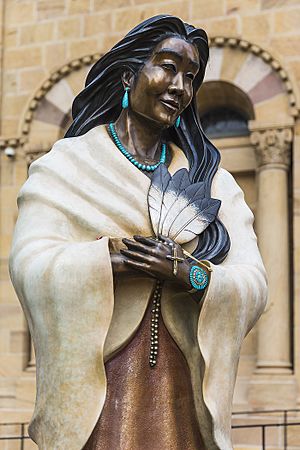
SITE Santa Fe shows new contemporary art. It aims to encourage artistic exploration. It hosts an international art show every two years.
Santa Fe has a lively modern art scene. Meow Wolf is a well-known art group. In 2016, they opened an amazing art space called House of Eternal Return.
Literature in Santa Fe
Many famous writers have lived in Santa Fe. These include D. H. Lawrence, Cormac McCarthy, Douglas Adams, Tony Hillerman, George R. R. Martin (author of Game of Thrones), and Rudolfo Anaya.
Music, Dance, and Opera in Santa Fe
Performance Santa Fe is the oldest performing arts group in the city. It was started in 1937. It brings famous musicians, dancers, and actors to Santa Fe all year. The Santa Fe Opera puts on shows from late June to late August. The city also hosts the Santa Fe Chamber Music Festival around the same time. This festival is held at the St. Francis Auditorium and the Lensic Theater. The Santa Fe Desert Chorale also has its summer festival in July and August.
Santa Fe has its own professional ballet company, Aspen Santa Fe Ballet. It performs in Santa Fe and tours around the world. The city is also home to María Benítez Institute for Spanish Arts. This institute offers programs and performances in Flamenco dance and Spanish guitar.
Famous Places to See in Santa Fe

- New Mexico State Capitol
- Cathedral Basilica of Saint Francis of Assisi
- Loretto Chapel
- Palace of the Governors
- San Miguel Mission (the oldest church in the U.S.)
- Santuario de Guadalupe
- Santa Fe Plaza
- Barrio De Analco Historic District
- La Cieneguilla Petroglyphs (ancient rock carvings)
Museums in Santa Fe
Santa Fe has many museums, especially near the downtown Plaza:
- New Mexico Museum of Art – shows modern and contemporary art from the Southwest.
- Museum of Contemporary Native Arts – focuses on modern Native American art.
- Georgia O'Keeffe Museum – dedicated to the famous artist Georgia O'Keeffe.
- New Mexico History Museum – tells the history of New Mexico.
- Site Santa Fe – a space for contemporary art.
Several other museums are on "Museum Hill":
- Museum of International Folk Art – has folk art from all over the world.
- Museum of Indian Arts and Culture – shows Native American arts.
- Wheelwright Museum of the American Indian – focuses on Native American art and history.
- Museum of Spanish Colonial Art – displays traditional arts from the Spanish colonial period.
Sports in Santa Fe
Santa Fe has been home to a few sports teams in the past, like the New Mexico Style (basketball) and the Santa Fe Roadrunners (hockey).
The city hosts the Rodeo De Santa Fe every year in late June.
Since 2012, Santa Fe has been home to the Santa Fe Fuego, a professional baseball team in the Pecos League of Professional Baseball Clubs. They play their games at Fort Marcy Ballfield.
Education in Santa Fe
Public schools in Santa Fe are run by Santa Fe Public Schools. The New Mexico School for the Arts is a special public high school focused on arts.
Santa Fe has three public high schools:
- Santa Fe High School
- Capital High School
- New Mexico School for the Arts
The city also has several colleges and universities:
- St. John's College – a liberal arts college.
- Institute of American Indian Arts – a college for Native American arts.
- Southwestern College – a graduate school for counseling and art therapy.
- Santa Fe Community College.
There are also many private high schools and elementary schools in Santa Fe. The Santa Fe Indian School is a special school for Native American students.
Getting Around Santa Fe
Air Travel
Santa Fe is served by the Santa Fe Regional Airport. You can fly from here to cities like Dallas/Fort Worth, Phoenix, Denver, and Houston.
Roads
Santa Fe is located on Interstate 25. Other major roads like U.S. Routes 84 and 285 also pass through the city.
The famous U.S. Route 66 used to run through Santa Fe from 1926 to 1937.
Public Transportation
Santa Fe Trails is the city's bus service. It runs routes within the city and connects to other regional transit.
The New Mexico Rail Runner Express is a train service. It connects Santa Fe to other cities like Albuquerque. Santa Fe has four train stations: Santa Fe Depot, South Capitol, Zia Road, and Santa Fe County/NM 599.
New Mexico Park and Ride also offers bus services to Santa Fe from nearby counties.
Greyhound Lines buses serve Santa Fe on their route from Denver to El Paso, Texas. Groome Transportation provides shuttle services to the Albuquerque International Sunport airport.
Trails for Walking and Biking
Santa Fe has many trails for biking, walking, and horseback riding. These are popular for fun and for getting around. Some famous trails include:
- The Dale Ball Trails – a 24.4-mile network close to the Santa Fe Plaza.
- The Santa Fe Rail Trail – a long trail leading to Lamy.
- The Atalaya Trail – going up Atalaya Mountain.
- The Santa Fe River Trail.
Santa Fe is also the end point for three National Historic Trails: El Camino Real de Tierra Adentro National Historic Trail, the Old Spanish National Historic Trail, and the Santa Fe National Historic Trail.
Santa Fe's Sister Cities
Santa Fe has "sister cities" around the world. These are cities that have special friendly relationships with Santa Fe.
 Bukhara, Uzbekistan (1988)
Bukhara, Uzbekistan (1988) Hidalgo del Parral, Mexico (1984)
Hidalgo del Parral, Mexico (1984) Holguín, Cuba (2001)
Holguín, Cuba (2001) Icheon, South Korea (2013)
Icheon, South Korea (2013) Livingstone, Zambia (2012)
Livingstone, Zambia (2012) San Miguel de Allende, Mexico (1992)
San Miguel de Allende, Mexico (1992) Santa Fe, Spain (1983)
Santa Fe, Spain (1983) Sorrento, Italy (1995)
Sorrento, Italy (1995) Tsuyama, Japan (1992)
Tsuyama, Japan (1992) Zhangjiajie, China (2009)
Zhangjiajie, China (2009)
Famous People from Santa Fe
Many notable people have lived in or are from Santa Fe:
- Mary Hunter Austin (1868–1934), writer
- Jimmy Santiago Baca (born 1952), poet
- Dana Tai Soon Burgess (born 1968), dancer and choreographer
- Julia Cameron (born 1948), author of The Artist's Way
- Zach Condon (born 1986), lead singer of the band Beirut
- Chris Eyre (born 1968), actor and director
- Tom Ford (born 1961), fashion designer
- Anna Gunn (born 1968), Emmy-winning actress
- Gene Hackman (born 1930), Oscar-winning actor
- George R. R. Martin (born 1948), author and screenwriter, known for Game of Thrones
- Cormac McCarthy (1933–2023), author, Pulitzer Prize winner
- Georgia O'Keeffe (1887–1986), famous artist
- Robert Redford (born 1936), actor and director
- Shirley MacLaine (born 1934), actress
- Wes Studi (born 1947), actor and musician
- Lew Wallace (1827–1905), governor and author of Ben-Hur
- Roger Zelazny (1937–1995), writer
Images for kids
See also
 In Spanish: Santa Fe (Nuevo México) para niños
In Spanish: Santa Fe (Nuevo México) para niños






